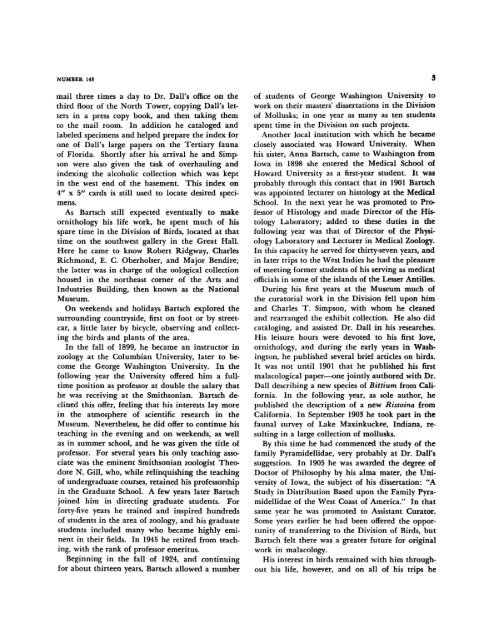Bibliography and Zoological Taxa of Paul Bartsch - Smithsonian ...
Bibliography and Zoological Taxa of Paul Bartsch - Smithsonian ...
Bibliography and Zoological Taxa of Paul Bartsch - Smithsonian ...
You also want an ePaper? Increase the reach of your titles
YUMPU automatically turns print PDFs into web optimized ePapers that Google loves.
NUMBER 143<br />
mail three times a day to Dr. Dall's <strong>of</strong>fice on the<br />
third floor <strong>of</strong> the North Tower, copying Dall's letters<br />
in a press copy book, <strong>and</strong> then taking them<br />
to the mail room. In addition he cataloged <strong>and</strong><br />
labeled specimens <strong>and</strong> helped prepare the index for<br />
one <strong>of</strong> Dall's large papers on the Tertiary fauna<br />
<strong>of</strong> Florida. Shortly after his arrival he <strong>and</strong> Simpson<br />
were also given the task <strong>of</strong> overhauling <strong>and</strong><br />
indexing the alcoholic collection which was kept<br />
in the west end <strong>of</strong> the basement. This index on<br />
4" x 5" cards is still used to locate desired specimens.<br />
As <strong>Bartsch</strong> still expected eventually to make<br />
ornithology his life work, he spent much <strong>of</strong> his<br />
spare time in the Division <strong>of</strong> Birds, located at that<br />
time on the southwest gallery in the Great Hall.<br />
Here he came to know Robert Ridgway, Charles<br />
Richmond, E. C. Oberholser, <strong>and</strong> Major Bendire;<br />
the latter was in charge <strong>of</strong> the oological collection<br />
housed in the northeast corner <strong>of</strong> the Arts <strong>and</strong><br />
Industries Building, then known as the National<br />
Museum.<br />
On weekends <strong>and</strong> holidays <strong>Bartsch</strong> explored the<br />
surrounding countryside, first on foot or by streetcar,<br />
a little later by bicycle, observing <strong>and</strong> collecting<br />
the birds <strong>and</strong> plants <strong>of</strong> the area.<br />
In the fall <strong>of</strong> 1899, he became an instructor in<br />
zoology at the Columbian University, later to become<br />
the George Washington University. In the<br />
following year the University <strong>of</strong>fered him a fulltime<br />
position as pr<strong>of</strong>essor at double the salary that<br />
he was receiving at the <strong>Smithsonian</strong>. <strong>Bartsch</strong> declined<br />
this <strong>of</strong>fer, feeling that his interests lay more<br />
in the atmosphere <strong>of</strong> scientific research in the<br />
Museum. Nevertheless, he did <strong>of</strong>fer to continue his<br />
teaching in the evening <strong>and</strong> on weekends, as well<br />
as in summer school, <strong>and</strong> he was given the title <strong>of</strong><br />
pr<strong>of</strong>essor. For several years his only teaching associate<br />
was the eminent <strong>Smithsonian</strong> zoologist Theodore<br />
N. Gill, who, while relinquishing the teaching<br />
<strong>of</strong> undergraduate courses, retained his pr<strong>of</strong>essorship<br />
in the Graduate School. A few years later <strong>Bartsch</strong><br />
joined him in directing graduate students. For<br />
forty-five years he trained <strong>and</strong> inspired hundreds<br />
<strong>of</strong> students in the area <strong>of</strong> zoology, <strong>and</strong> his graduate<br />
students included many who became highly eminent<br />
in their fields. In 1945 he retired from teaching,<br />
with the rank <strong>of</strong> pr<strong>of</strong>essor emeritus.<br />
Beginning in the fall <strong>of</strong> 1924, <strong>and</strong> continuing<br />
for about thirteen years, <strong>Bartsch</strong> allowed a number<br />
<strong>of</strong> students <strong>of</strong> George Washington University to<br />
work on their masters' dissertations in the Division<br />
<strong>of</strong> Mollusks; in one year as many as ten students<br />
spent time in the Division on such projects.<br />
Another local institution with which he became<br />
closely associated was Howard University. When<br />
his sister, Anna <strong>Bartsch</strong>, came to Washington from<br />
Iowa in 1898 she entered the Medical School <strong>of</strong><br />
Howard University as a first-year student. It was<br />
probably through this contact that in 1901 <strong>Bartsch</strong><br />
was appointed lecturer on histology at the Medical<br />
School. In the next year he was promoted to Pr<strong>of</strong>essor<br />
<strong>of</strong> Histology <strong>and</strong> made Director <strong>of</strong> the Histology<br />
Laboratory; added to these duties in the<br />
following year was that <strong>of</strong> Director <strong>of</strong> the Physiology<br />
Laboratory <strong>and</strong> Lecturer in Medical Zoology.<br />
In this capacity he served for thirty-seven years, <strong>and</strong><br />
in later trips to the West Indies he had the pleasure<br />
<strong>of</strong> meeting former students <strong>of</strong> his serving as medical<br />
<strong>of</strong>ficials in some <strong>of</strong> the isl<strong>and</strong>s <strong>of</strong> the Lesser Antilles.<br />
During his first years at the Museum much <strong>of</strong><br />
the curatorial work in the Division fell upon him<br />
<strong>and</strong> Charles T. Simpson, with whom he cleaned<br />
<strong>and</strong> rearranged the exhibit collection. He also did<br />
cataloging, <strong>and</strong> assisted Dr. Dall in his researches.<br />
His leisure hours were devoted to his first love,<br />
ornithology, <strong>and</strong> during the early years in Washington,<br />
he published several brief articles on birds.<br />
It was not until 1901 that he published his first<br />
malacological paper—one jointly authored with Dr.<br />
Dall describing a new species <strong>of</strong> Bittium from California.<br />
In the following year, as sole author, he<br />
published the description <strong>of</strong> a new Rissoina from<br />
California. In September 1903 he took part in the<br />
faunal survey <strong>of</strong> Lake Maxinkuckee, Indiana, resulting<br />
in a large collection <strong>of</strong> mollusks.<br />
By this time he had commenced the study <strong>of</strong> the<br />
family Pyramidellidae, very probably at Dr. Dall's<br />
suggestion. In 1905 he was awarded the degree <strong>of</strong><br />
Doctor <strong>of</strong> Philosophy by his alma mater, the University<br />
<strong>of</strong> Iowa, the subject <strong>of</strong> his dissertation: "A<br />
Study in Distribution Based upon the Family Pyramidellidae<br />
<strong>of</strong> the West Coast <strong>of</strong> America." In that<br />
same year he was promoted to Assistant Curator.<br />
Some years earlier he had been <strong>of</strong>fered the opportunity<br />
<strong>of</strong> transferring to the Division <strong>of</strong> Birds, but<br />
<strong>Bartsch</strong> felt there was a greater future for original<br />
work in malacology.<br />
His interest in birds remained with him throughout<br />
his life, however, <strong>and</strong> on all <strong>of</strong> his trips he

















